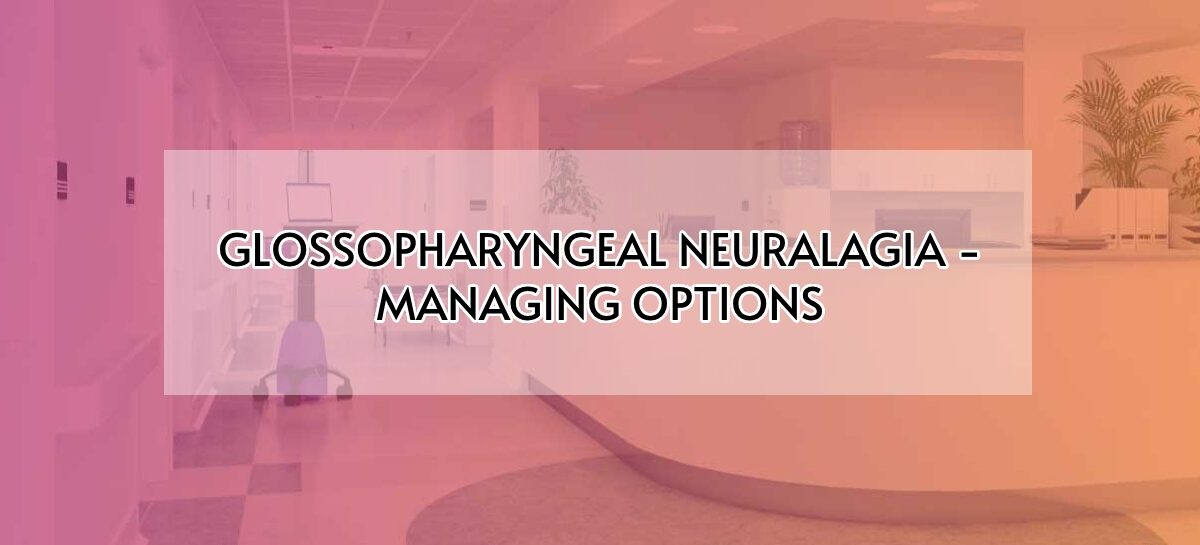Introduction
Glossopharyngeal neuralgia (GN) is a rare pain syndrome, characterized by an abrupt onset of brief episodic unilateral/bilateral pain, with sharp and stabbing in character, along the glossopharyngeal nerve distribution region (angle of the jaw, ear, tonsillar fossa and the tongue base). The pain of glossopharyngeal neuralgia follows a relapsing and remitting pattern. Occasionally, the painful attacks of glossopharyngeal neuralgia were associated with syncope transient or persistent bradycardia, asystole, and even seizures (Vagoglossopharyngeal neuralgia). Usually the symptoms often triggered by persisting cough, talking, or swallowing. Symptoms and signs are often confused with trigeminal neuralgia (TN) pain because of both the conditions share similar area of distribution and characters. Among all the cranial neuralgias, the glossopharyngeal neuralgia is extremely rare and difficult to treat. This article is dealing with the various clinical presentations and some management options of glossopharyngeal neuralgia with a clinical scenario.
Clinical types and presentation
A young woman admitted for severe cough with acute febrile illness. She has been diagnosed as influenza pneumonia and treated for that, subsequently she developed right sided facial pain along with ear pain, which precipitated on talking, swallowing and opening of jaw. The pain was more towards the ear and ankle of mandible, notably severe, flash like pain aggravated on above mentioned situation. The pain was not controlled by regular NSAIDS and intravenous medications. Meanwhile, she was recovering from pneumonia, but not from pain. In further imaging, it was found out to be bilateral elongated styloid process. Finally, the cause of her pain was diagnosed to be EAGLE’S SYNDROME. Then the patient was successfully treated with carbamazepine and right sided glossopharyngeal nerve block.
Clinical types:
Classical
Essential or idiopathic glossopharyngeal neuralgia (etiology is unknown)
Secondary
- Vascular compression, mainly at the nerve root: (the most common)
- Demyelinating diseases
- Inflammatory and autoimmune diseases
- Intraoral and peritonsillar infections
- Intracranial space-occupying lesions( CP angle)
- Posterior fossa and cervical malformations
- Eagle syndrome or stylalgia: styloid process is over 25mm or the calcified stylohyoid ligament
- Oropharyngeal cancers
Diagnostic criteria of glossopharyngeal neuralgia:
| A. Recurring paroxysmal attacks of unilateral pain in the distribution of the glossopharyngeal nerve and fulfilling criterion B |
B. Pain has all of the following characteristics:
|
| C. Not better accounted for by another International Classification of Headache Disorders‐third edition |
|
|
|
Treatment options
GPN, at least during the early stage, tends to be responsive to medications, but for the GPN symptoms are medically intractable, then various interventional pain management and surgical options are advised depending upon the type of the disease.
PHARMOCOTHERAPHY – carbamazepine, gabapentenoids, phenytoin and other antineuropathic medications
INTERVENTIONAL PAIN MANAGEMENT – Nerve blocks with steroids, Chemical neurolysis and RF ablation
SURGICAL MANAGEMENT – Micro vascular Decompression, Gama knife neurolysis, Styloid process/ styloid ligament excision
Conclusion:
In conclusion, always the symptoms of GPN must be carefully evaluated and differentiated from other pain syndromes, especially TN. The success of diagnosis and treatment of GPN needs a good multidisciplinary approach, the team include PHYSICIAN,ENT surgeon interventional PAIN PHYSICIAN and good nursing care. The effectiveness of the treatment modality depends upon the nature of the disease and it should be individualized to every patient.
References:
- J Korean Neurosurg Soc 66 (1) : 12-23, 2023 https://doi.org/10.3340/jkns.2022.0178
- Glossopharyngeal NeuralgiaRutvij J. Shah; Devang Padalia. Bookshelf ID: NBK541041PMID: 31082085
- Effectiveness of Radiofrequency Ablation for Treatment of Glossopharyngeal Neuralgia: A Systematic Review of the Current Literature, Pain Physician 2024; 27:97-110 • ISSN 1533-3159
 Dr. Karthickraja Velayutham
Dr. Karthickraja Velayutham
Senior Consultant Anaesthesiologist
Kauvery Hospital Chennai



